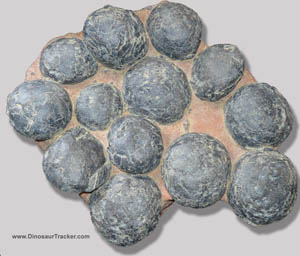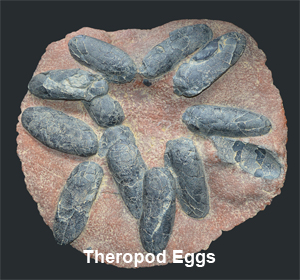Fossil Dinosaur Eggs
Global Flood | See All The Videos. Go to the: 30 Second Video Menu

"Eggs were everywhere. As we strode across the mud-cracked flats exposed beneath the banded ridges of crimson rock that radiated under the searing Patagonian sun, crew members began kneeling down to examine small, dark gray fragments of rounded rock with a curious texture. We knew immediately from the distinctive texture that we had found something startling--dinosaur eggs." (Luis Chiappe and Lowell Dingus, "Walking On Eggs,” Scribner (2001), page 23)

As with dinosaur tracks, dinosaur eggs provide powerful evidence that a Biblical global flood is real and actually happened. Let’s start with an important question few people ask: Were Fossil Dinosaur Eggs Laid Normally?
It is estimated that over a billion dinosaur eggs have been found, along with huge amounts of broken eggs and eggshell. In one area in Spain, for example, it is estimated there are 300,000 eggs. This is a huge abundance of dinosaur eggs... all laid out in the open. That's right. No nests. Just clutches of eggs, with additional eggs scattered about between the clutches. This should raise a question: Were dinosaur eggs laid normally? The answer is, they were not.
It is rare to find dinosaur eggs with embryos inside. It is also extremely rare to find fossil bones near dinosaur eggs. Eggs are found out in the open, on flat sediment surfaces, with little or no evidence of vegetation. Flat mud plains with nothing growing. That's odd.
And there is little fossil evidence (make that essentially none) that the dinosaur that laid the eggs stayed with their eggs. No nests. No parents. What would protect them from predators? All of this is very odd.

The question of dinosaur egg preservation and fossilization is similar to that for dinosaur footprints. Eggs must be quickly and deeply buried, in this case to protect them from predators. However, the flow of water carrying the sediment must be gentle so as not to break or move the eggs. Let's think about this. To get enough sediment to quickly and deeply bury eggs (two or three feet of sediment is required for this) requires an energetic water flow that can even erode rock quickly. Based on the present being the key to the past, that means a flash flood type of flow. That is what it takes today to produce a lot of sediment. However, such an energetic flash flood will move and break the eggs. Therefore, it is not an option. We do not see any mechanism operating today that could bury, preserve, and fossilize eggs.
Here is another interesting piece of evidence: Some dinosaur eggs have been found in marine strata such as chalk. however, chalk forms underwater. Dinosaurs do not lay eggs underwater, and eggs are too fragile to have been carried there by a flood. Maybe they were carried in floating vegetation? Seems far-fetched.
The formation of an egg is a complicated process that takes place within the dinosaur. The last step is putting the hard shell on the egg. Then it is stored in the mother's body until all of the eggs can be laid. If the mother is under stress and is prevented from laying the eggs, some of the eggs may have pathologies, meaning they are not normal. A common pathology is multiple shells. If the egg is unable to be moved into the storage area in the lower uterus, and it stays in the shell making area of the uterus, a second shell will form. Only the most recent eggs to form within the mother would have this pathology. When dinosaur eggs are examined using an electron microscope these multiple shells can sometimes be detected. In one example 10% of fossil dinosaur eggs were found to have multiple shells. That is far in excess of what is common under normal conditions.
"Abnormal, multilayered eggshells are frequently reported in fossil specimens. Excavation of one clutch exposed 30 eggs, distributed in three levels, including 27 normal eggs and 3 multilayered eggs. The three abnormal eggs occupied the highest level within the clutch and represent the last eggs laid by the female sauropod." (Jackson, Garrido, Schmitt, Chiappe, Dingus, and Loope, "Abnormal, Multilayered Titanosaur Eggs from in situ Clutches at the Auca Mahuevo locality, Neuquén Province, Argentina," Journal of Vertebrate Paleontology v24, 10/12/2004)
As we put the pieces together the evidence points to dinosaurs under stress, on flat mud plains with no vegetation. They are in a situation in which they can't lay their eggs... they are holding them in and some eggs develop multiple shells. Finally, they lay their eggs, sometimes in clutches, but they are in a hurry so others are scattered about, and then they move on. Very soon afterwards (before predators find them) the eggs are gently, yet quickly and deeply buried (unhatched) and fossilized. We don't see anything like this today, nor in recorded history, EXCEPT... in the Bible. The Genesis flood would produce the dinosaur egg evidence we see today.
The above is based on chapter 13 in A Beginner's Guide to Tracking Dinosaurs."
Dinosaur Eggs Point to the Global Genesis Flood (CMI)
Evidence of Dinosaur Nest Construction is Extremely Rare (CIM)
Dinosaur Eggs Not Bird-Like After All (ICR)

Everything is falling apart, nothing makes sense anymore. What's happening?
What is happening is that the world has turned away from God. When nations turn away from God, strangely enough, God turns His back on them. We find out what it is like to live without God.
There is only one thing to do... repent, turn to Jesus Christ in obedience. Jesus said:
If you love Me, you will keep My commandments. - John 14:15
This can only be done on an individual basis. Don't look to others turning to God and making things better for you. YOU must repent, turn away from disobedience. Love God! Obey what He says. Read the Bible to find out what He says.
It happens one person at a time, starting with you. Don't put it off today. Turn to Jesus Christ, God who came to earth in human flesh to save us from the penalty we've earned as a result of our disobedience (sin). He will do it! ...
BUT ONLY when you believe this is true and put your trust in Jesus. Trust Jesus today. Repent (turn away from what the world wants and to what God wants).
Jesus began to preach, “Repent, for the kingdom of heaven has come near.” - Matthew 4:17